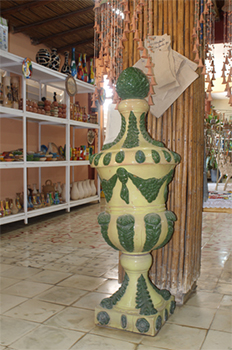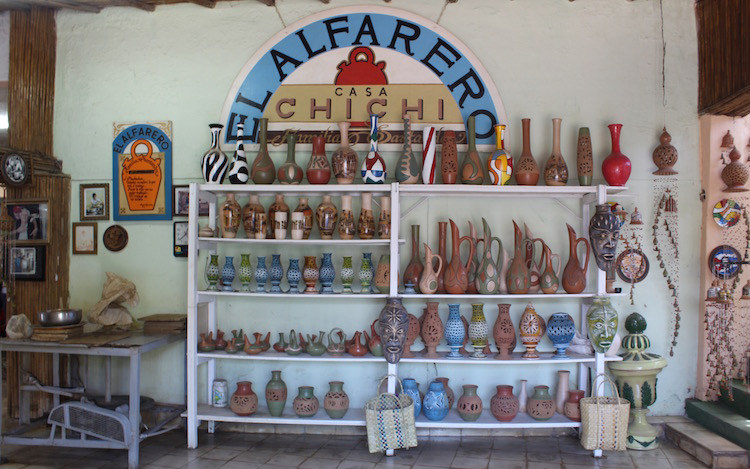When the wind blows, ceramic bells tinkle as the clappers strike one another, attracting customers into a room filled with rainbow vases, cups, plates and candle holders along with other home decor. Some pieces are simple and brown without any designs or gloss. Some have different painted patterns circling them such as green and yellow zig zags while others feature more intricate designs. As if there isn’t enough color in town from the radiantly painted houses, the ceramics in this dimly lit room brightens up the place into a rainbow paradise.
Where is this paradise that have I stepped into? El Alfafrero.
In this famous ceramic factory and shop located in Trinidad, Cuba, the artisans create their next masterpiece. Along with current owner, Daniel Santander Alcántara, 73, they spend their days molding clay, crafting intricate designs and continuing the tradition of bringing clay to life.
This ceramic shop has been selling pieces for six generations. “My great-grandfather started this tradition of creating ceramics,” said Daniel. “His name was Rogelio Santander Ortega. He was from Santander, Spain. He came to Cuba and started making ceramics. Once my grandfather got a hold of the business, it soon became a profession.”
Now, people from all over the world come to visit this famous shop.
“In Trinidad, if you mention El Alfarero, the people will know what you are talking about. It has been famous for generations,” said Yosleivy Abrahantes, 40, a Trinidad native and local tour guide.
“People love the colorful ceramics here,” said Santander. “The three most popular pieces are the sonajeros (hanging bells), the canchánchara (small cups) and the quinqués (candle holders).”

Some of the sonajeros hanging near the entrance of El Alfarero. | Julissa Ramirez
The sonajeros begin with a bell that can be as small as the width of one’s finger to as big as the width of one’s hand. These bells are designed with different shapes. Tied to the bottom of these bells are strings that hold evenly separated balls of clay leading to the very bottom of the string that ends with a miniature bell or sombrero. These pieces range from 7 CUC (about $7) to 70 CUC.
The canchánchara is a small, round cup used to serve a local cocktail of lemon juice, rum, water and honey. These pieces are plainer in comparison to the sonajeros. They are brown and have a bunch of vertical dashes circling the middle of the cup and see for 2 CUC.
The quinqués come in all shapes and sizes. Some are short, similar to a bowl while others are tall, resembling a vase. Like the sonajeros, they are designed with different shapes and patterns and come in colors such as blue, green, brown and red. The quinqués range from 2 CUC to 25 CUC.

Some of the many quinqués being displayed on a table. | Julissa Ramirez
One of their most famous pieces is the macetas coloniales (colonial pots) which is located in the Plaza Mayor, a main square in Trinidad. “I think the reason why they are so popular is because they are emblematic. Many people go to the Plaza Mayor and it is visited by many tourists,” said Santander. “The pot originally came from Spain. About 40 years ago, it started to deteriorate and we were asked to fix it. At first, I didn’t want to do the job because I would have needed to stop doing lot of the work that I was already doing in my factory, but it was something that was necessary for the city. I love Trinidad so I accepted to the job. The pot lasted for about 35 years, so we recently made a new one. I think it will last just as long again.”

A maceta coloniale. | Julissa Ramirez
Sculpting the ceramics may only take a few minutes, but there is a much longer process that must occur before selling it to the rest of Cuba. “When we first get the clay, it gets cleaned and processed,” said Santander. “Once it is ready, we shape it into the piece we want and then leave it to dry for a couple of days. After that, we follow a technique that my grandfather started called gruñido puiado. This is when we sand them and give the clay its rich color. Once that is done, we put them in the oven to 1000 degrees celsius.”
The Plaza Mayor is not the only place Santander has made orders for, he also creates pieces for hotels and restaurants as well. “Recently, we have been doing quite a lot of plates and dishes for restaurants and hotels. Three years ago, we made some pots for the Romance Museum here in Trinidad. If you go to the square, you will notice that they are brand new. I have also manufactured a dozen pots for the Havana theatre called Jose Martí,” said Santander.
In the midst of Santander’s much larger orders, he refuses to forget about the locals and their small requests. “My main customers are tourists. They are from all over the world—America, Europe, the Caribbean, Asia. I am willing to do customized pieces too. If the clients will draw what they want or if they have a clear idea of what they would like, I am willing to create it,” said Santander.

Current owner, Daniel Santander Alcántara, sculpting bells. | Julissa Ramirez
Santander has continued to create a welcoming environment for the people of Trinidad as well as the newcomers. He makes sure to have all his customers leaving with a smile and ready to brighten up a different part of the world with his artwork.
“I love my work,” said Santander. “I am proud of my ancestors. My grandfather Rogelio is a marvelous person and so is my father. My father loved ceramics so much that he had a saying, “solo el amor convierte en milagro el barro” (only love can make clay become a miracle). For me the most important thing is to continue the tradition. I want to make sure people love my pieces and all the work that my family and I do.”
El Alfarero; 51 Abel Santamaría and Pepito Tey Street, Tinidad, Cuba; (41)993-146; 8:30 a.m.-8:30 p.m. daniel@hero.cult.cu
Travel Journalism, Photography & Video Internship Seminar in Havana and Trinidad, Cuba

